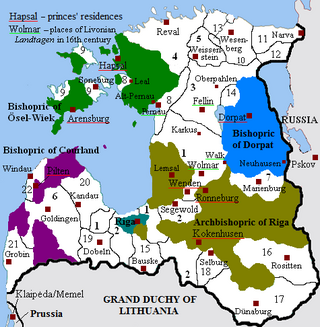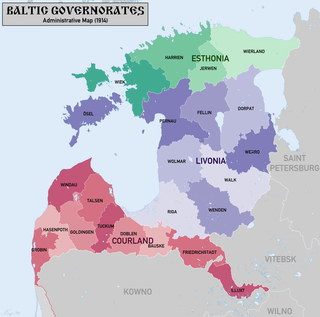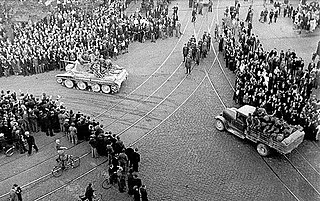Related Research Articles

Livonia is a historical region on the eastern shores of the Baltic Sea. It is named after the Livonians, who lived on the shores of present-day Latvia.

The Treaty of Brest-Litovsk was a separate peace treaty signed on 3 March 1918 between Russia and the Central Powers, that ended Russia's participation in World War I. The treaty was signed at German-controlled Brest-Litovsk, after two months of negotiations. The treaty was agreed upon by the Russians to stop further invasion. As a result of the treaty, Soviet Russia defaulted on all of Imperial Russia's commitments to the Allies and eleven nations became independent in eastern Europe and western Asia. Under the treaty, Russia lost all of Ukraine and most of Belarus, as well as its three Baltic republics of Lithuania, Latvia, and Estonia, and these three regions became German vassal states under German princelings. Russia also ceded its province of Kars in the South Caucasus to the Ottoman Empire. According to historian Spencer Tucker, "The German General Staff had formulated extraordinarily harsh terms that shocked even the German negotiator." Congress Poland was not mentioned in the treaty. When Germans later complained that the 1919 Treaty of Versailles against Germany was too harsh on them, the Allied Powers responded that it was more benign than the terms imposed by the Brest-Litovsk treaty.

Baltic Germans were ethnic German inhabitants of the eastern shores of the Baltic Sea, in what today are Estonia and Latvia. Since their coerced resettlement in 1939, Baltic Germans have markedly declined as a geographically determined ethnic group. However, it is estimated that several thousand people with some form of (Baltic) German identity still reside in Latvia and Estonia.

The Baltic states or the Baltic countries is a geopolitical term, which currently is used to group three countries: Estonia, Latvia, and Lithuania. All three countries are members of NATO, the European Union, the Eurozone, and the OECD. The three sovereign states on the eastern coast of the Baltic Sea are sometimes referred to as the "Baltic nations", less often and in historical circumstances also as the "Baltic republics", the "Baltic lands", or simply the Baltics.

The United Baltic Duchy, or alternatively the Grand Duchy of Livonia, was the name proposed during World War I by leaders of the local Baltic German nobility for a new monarchical state, but it never came into existence. The unsuccessful attempt to establish a new German client state on the territory of what is now Latvia and Estonia was made in 1918, during the German occupation of the former Courland, Livonian and Estonian governorates of the Russian Empire which had ceased to exist after the Bolshevik coup in 1917. The unsuccessful proclamation of a pro-German duchy was first made in April 1918, after the Republic of Estonia had already formally declared full independence.

The Baltic states of Estonia, Latvia and Lithuania were invaded and occupied in June 1940 by the Soviet Union, under the leadership of Stalin and auspices of the Molotov-Ribbentrop Pact that had been signed between Nazi Germany and the Soviet Union in August 1939, immediately before the outbreak of World War II. The three countries were then annexed into the Soviet Union in August 1940. The United States and most other Western countries never recognised this incorporation, considering it illegal. On 22 June 1941, Nazi Germany attacked the Soviet Union and within weeks occupied the Baltic territories. In July 1941, the Third Reich incorporated the Baltic territory into its Reichskommissariat Ostland. As a result of the Red Army's Baltic Offensive of 1944, the Soviet Union recaptured most of the Baltic states and trapped the remaining German forces in the Courland pocket until their formal surrender in May 1945.

The Baltic governorates, originally the Ostsee governorates, was a collective name for the administrative units of the Russian Empire set up in the territories of Swedish Estonia, Swedish Livonia (1721) and, afterwards, of the Duchy of Courland and Semigallia (1795).

The Declaration of the Rights of the Peoples of Russia was a document promulgated by the Bolshevik government of Russia on November 15, 1917.

Border states, or European buffer states, were the European nations that won their independence from the Russian Empire after the Bolshevik Revolution of 1917, the Treaty of Brest-Litovsk and ultimately the defeat of the German Empire and Austria-Hungary in World War I. During the interwar period, the nations of Western Europe implemented a border states policy, which aimed at uniting them in protection against the Soviet Union and communist expansionism. The border states were interchangeably Finland, Estonia, Latvia, Lithuania, Poland, Romania and, until their annexation into the Soviet Union, short-lived Belarus and Ukraine.
Territorial changes of the Baltic states refers to the redrawing of borders of Lithuania, Latvia and Estonia after 1940. The three republics, formerly autonomous regions within the former Russian Empire and before that of former Polish–Lithuanian Commonwealth and as provinces of the Swedish Empire, gained independence in the aftermath of World War I and the Russian Revolution of 1917. After a two-front independence war fought against both Bolshevist Russian and Baltic German nationalist forces, the countries concluded peace and border treaties with Soviet Russia in 1920. However, with World War II and the occupation and annexation of these republics into the Soviet Union twenty years after their independence, certain territorial changes were made in favour of the Russian SFSR. This has been the source of political tensions after they regained their independence with the dissolution of the Soviet Union. Some of the disputes remain unresolved.

The Treaty of Tartu is a peace treaty that was signed in Tartu on 2 February 1920 between the Republic of Estonia and Soviet Russia, ending the 1918–1920 Estonian War of Independence. In the treaty, Bolshevik Russia recognized the independence of the newly established democratic state of Estonia.

The Soviet–Lithuanian Peace Treaty, also known as the Moscow Peace Treaty, was signed between Lithuania and Soviet Russia on July 12, 1920. In exchange for Lithuania's neutrality and permission to move its troops in the territory that was recognised during its war against Poland, Soviet Russia recognized the sovereignty of Lithuania. The treaty was a major milestone in Lithuania's struggle for international recognition and recognised Lithuania's eastern borders. Interwar Lithuania officially maintained that its de jure borders were those delineated by the treaty although a large territory, the Vilnius Region, was actually controlled by Poland.

The Duchy of Courland and Semigallia was the name for a proposed client state of the German Empire during World War I which did not come into existence. It was proclaimed on 8 March 1918, in the German-occupied Courland Governorate by a council composed of Baltic Germans, who offered the crown of the once-autonomous duchy to Kaiser Wilhelm II, despite the existence of a formerly sovereign reigning family in that duchy, the Biron descendants of Ernst Johann von Biron. Although the German Reichstag supported national self-determination for the peoples of the Baltic provinces, the German High Command continued the policy of attaching these territories to the German Reich by relying on the local Baltic Germans.

The Soviet occupation of Latvia in 1940 refers to the military occupation of the Republic of Latvia by the Soviet Union under the provisions of the 1939 Molotov–Ribbentrop Pact with Nazi Germany and its Secret Additional Protocol signed in August 1939. The occupation took place according to the European Court of Human Rights, the Government of Latvia, the United States Department of State, and the European Union. In 1989, the USSR also condemned the 1939 secret protocol between Nazi Germany and herself that had led to the invasion and occupation of the three Baltic countries, including Latvia.

Relevant events began regarding the Baltic states and the Soviet Union when, following Bolshevist Russia's conflict with the Baltic states—Lithuania, Latvia and Estonia—several peace treaties were signed with Russia and its successor, the Soviet Union. In the late 1920s and early 1930s, the Soviet Union and all three Baltic States further signed non-aggression treaties. The Soviet Union also confirmed that it would adhere to the Kellogg–Briand Pact with regard to its neighbors, including Estonia and Latvia, and entered into a convention defining "aggression" that included all three Baltic countries.
The timeline of the occupation of the Baltic states lists key events in the military occupation of the three countries – Estonia, Latvia and Lithuania – by the Soviet Union and by Nazi Germany during World War II.

The background of the occupation of the Baltic states covers the period before the first Soviet occupation on 14 June 1940, stretching from independence in 1918 to the Soviet ultimatums in 1939–1940. Lithuania, Latvia, and Estonia gained independence in the aftermath of the Russian revolutions of 1917 and the German occupation which in the Baltic countries lasted until the end of World War I in November 1918. All three countries signed non-aggression treaties with the Soviet Union in the 1920s and 1930s. Despite the treaties, in the aftermath of the 1939 German–Soviet pact, Estonia, Latvia and Lithuania were occupied, and thereafter forcibly incorporated into the Soviet Union, in 1940.

The Soviet Union (USSR) occupied most of the territory of the Baltic states in its 1944 Baltic Offensive during World War II. The Red Army regained control over the three Baltic capitals and encircled retreating Wehrmacht and Latvian forces in the Courland Pocket where they held out until the final German surrender at the end of the war. The German forces were deported and the leaders of Latvian collaborating forces were executed as traitors. After the war, the Baltic territories were reorganized into constituent republics of the USSR until they declared independence in 1990 amid the dissolution of the Soviet Union in 1991.
Central Powers intervention in the Russian Civil War consisted of a series of multi-national military expeditions starting in 1918. This was intervention was picking up from the Eastern Front against the newly set up Russian Republic. The main goals of the intervention were to maintain the territories received in the Treaty of Brest-Litovsk, prevent a re-establishment of the Eastern Front, and administer new conquered territories. After the defeat of the Central Powers, many armies that stayed mostly helped the White movement eradicate communists in the Baltics until their eventual withdrawal and defeat. In addition, pro-German factions fought against the newly independent Baltic states until their defeat by the Baltic States, backed by the victorious Allies.
The seminal use of cordon sanitaire as a metaphor for ideological containment referred to "the system of alliances instituted by France in post-World War I Europe that stretched from Finland to the Balkans" and which "completely ringed Germany and sealed off Russia from Western Europe, thereby isolating the two politically 'diseased' nations of Europe."
References
- ↑ "Definition of LIMITROPHE". www.merriam-webster.com.
- ↑ Calvo, Carlos (2009). Dictionnaire Manuel de Diplomatie et de Droit International Public et Privé. The Lawbook Exchange, Ltd. p. 246. ISBN 9781584779490.
- ↑ Georges, Karl Ernst (1998). Ausführliches lateinisch-deutsches Handwörterbuch. Nachdruck Darmstadt. p. Band 2, Sp. 660.
- ↑ Smele, John (1996). Civil war in Siberia: the anti-Bolshevik government of Admiral Kolchak, 1918-1920. London: Cambridge University Press. p. 305.
- ↑ Filiushkin, Alexander (2008). Ivan the Terrible: a military history. Frontline Books. p. 264. ISBN 9781848325043.
- ↑ Волин, Б.. Лимитрофы. Малая Советская энциклопедия. М.: 1929, — т.4, стлб.641.
- ↑ Лимитроф. Толковый словарь русского языка. Под ред. проф. Д.Н.Ушакова. т. 2. — М.:ОГИЗ, 1938. — стлб.61.